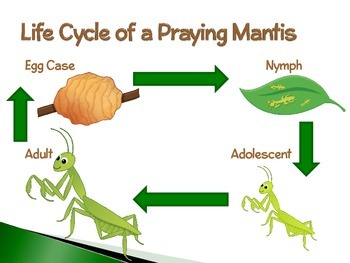The Praying Mantis
Classification of Mantis or Praying Mantis
Kingdom: Animalia
Phylum : Arthropoda
Class : Insecta
Ordo : Mantodea
The praying mantis is
named for its prominent front legs, which are bent and held together at
an angle that suggests the position of prayer. They were considered to have supernatural power by early civilizations, including Ancient Greece and Ancient Egypt. It is most commonly kept as pets.
|
The praying mantis belong to the order of Mantodea. There are about 2300 species of praying mantis described. There are about 2300 species of praying mantis described. They can be found in every continent except on Antarctica. But most extraordinary species and highest number of species can only be
found in the tropical forest of South America, Africa and Asia.Life Cycle of a Praying Mantis | |||
 | ||
Praying mantis are part of the hemimetabola group of insects; this means they do not undergo a complete metamorphosis like a butterfly or beetle. There are 4 stages of the mantis' life cycle; egg case, nymph, adolescent, and adult. On the first stage, the adult female praying mantis lays 100 to 400 eggs after
fertilization. The eggs are laid safely on a firm leaf or stem with a
liquid that hardens to be a protective sac structure known as ootheca. When the temperatures are warm, the nymphs will hatch when the egg cases crack to the second stage. The newborn nymphs are almost the same as the parents except their size,
color and their wings. On this stage, These mantis nymphs shed their skin around 6 – 9
times before reaching adolescence. They start to hunt for small insects and they are vulnerable as prey to other predators. Therefore, not all nymphs survive this stage.The adolescent mantises are larger in size than nymphs. They shed their
skin exoskeletons occasionally, a feature that differentiates them from adult
mantises. Mantises tend to be sluggish before they molt and will rarely
feed during this period. Molting increases their vulnerability as prey
as it takes a few hours and the mantis remains at one place. The molting
process ends at the beginning of summer, when it has grown to be a
mature adult. Full-grown mantises are normally between 1 to 6 inches in length, and are different in size depending on their species. Full-grown mantises are normally between 1 to 6 inches in length, and are different in size depending on their species. They eat mostly moths, crickets, grasshoppers, flies, and other insects. Their average life span in the wild: 1 years.Fun FactsPraying mantis have some special features which makes them unique among insects. First, they are able to turn their heads around like humans can. All other insects cannot turn their heads, their neck is too rigid to allow it. Furthermore, they can turn it 180 degrees to scan their surroundings with two large compound eyes. They also have modified front legs; these front legs are especially designed to catch prey and hold them tightly. These arms are very strong and equipped with pointy spikes to keep a firm hold on the prey. Most adult praying mantis have wings. Typically green or brown and well camouflaged on the plants, mantis lie in ambush or patiently stalk their quarry. They use their front legs to snare their prey with reflexes so quick that they are difficult to see with the naked eye.source : https://www.nationalgeographic.com/animals/invertebrates/p/praying-mantis/ https://en.wikipedia.org/wiki/Mantis https://www.keepinginsects.com/praying-mantis/general/ https://www.keepinginsects.com/praying-mantis/ http://animals.mom.me/stages-praying-mantis-life-cycle-6282.html |

Komentar
Posting Komentar